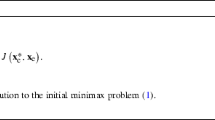Abstract
This work is devoted to the development of a new and efficient procedure for the construction of adaptive model-based designs of experiments. This work couples kriging theory with design of experiments optimization techniques and its originality relies on two main ingredients: (i) the definition of a general criterion in the objective function that allows one to take into account the analyst’s choices in order to explore critical regions, and (ii) an efficient numerical implementation including a stabilization step to avoid numerical problems due to kriging matrix inversion and a computational cost reduction strategy that allows for the model’s use in industrial applications. After a full description of these key points, the resulting efficient algorithm is applied to extend over a territory in France a network of probes for environmental monitoring. This study leads to a final design of experiments where the new probes are located in undersampled regions of high population density. Moreover, it can be performed with an affordable computational cost, which is not the case with classical approaches based on an optimization over the whole domain.











Similar content being viewed by others
Notes
One measurement is above 0.25 μGy/h. This can be explained by the effect of the altitude.
\(p_{\mathcal{V}} > \mathcal{K}_{\mathcal{V}}\) when the first term of the sum vanishes (see the example of a Gaussian semi-variogram at the end of the section).
References
Ababou R, Bagtzoglou A, Wood E (1994) On the condition number of covariance matrices in kriging, estimation and simulation of random fields. Math Geol 26(1):99–133
Barnes R, Watson A (1992) Efficient updating of kriging estimates and variances. Math Geol 24(1):129–133
Benesty J, Gansler T (2006) Computation of the condition number of a nonsingular symmetric Toeplitz matrix with the Levinson-Durbin algorithm. IEEE Trans Signal Process 54(6):2362–2364
Chevalier C, Bect J, Ginsbourger D, Picheny V, Richet Y, Vazquez E (2012) Fast kriging-based stepwise uncertainty reduction with application to the identification of an excursion set. Submitted to Technometrics
Chiles JP, Delfiner P (1999) Geostatistics: modelling spatial uncertainty. Wiley, New York. 695 pp
Chojnacki E, Ounsy A (1996) Description of the IPSN method for the uncertainty and sensitivity analysis and the associated software. In: SUNSET. ASME/JSME ICONE, Louisiana, USA, vol 3, pp 545–550
Cressie NA (1993) Statistics for spatial data. Wiley, New York. 900 pp
Delmelle EM, Goovaerts P (2009) Second-phase sampling designs for non-stationary spatial variables. Geoderma 153(1–2):205–216
Emery X (2009) The kriging update equations and their application to the selection of neighboring data. Comput Geosci 13(1):211–219
Fang K, Li R, Sudjianto A (2006) Design and modeling for computer experiments. Chapman & Hall/CRC, London. University of Michigan, 290 pp
Goovaerts P (1997) Geostatistics for natural resources evaluation. Oxford University Press, New York. 483 pp
Gray R (2006) Toepliz and circulant matrices: a review. Now Publishers Inc, Boston-Delft. 93 pp
Gubian S, Xiang Y, Suomela B, Hoeng J (2012) Generalized simulated annealing for efficient global optimization: the GenSA. Package for R. R J. doi:10.1115/1.4001873. http://journal.r-project.org
McKay M, Conover W, Beckman R (1979) A comparison of three methods for selecting values of input variables in the analysis of output from a computer code. Technometrics 21:239–245
Myers R, Montgomery D (1995) Response surface methodology-process and product optimization using design experiments. Wiley-Blackwell, New York. 704 pp
Niederreiter H (1992) Random number generators and quasi-Monte Carlo methods. SIAM, Philadelphia. 247 pp
O’Dowd R (1991) Conditioning of coefficient matrices of ordinary kriging. Math Geol 23(5):721–739
Pardo-Iguzquiza E (1998) Optimal selection of number and location of rainfall gauges for areal rainfall estimation using geostatistics and simulated annealing. J Hydrol 210:206–220
Picheny V, Ginsbourger D, Roustant O, Haftka RT (2010) Adaptive designs of experiments for accurate approximation of a target region. J Mech Des 132(7):071008. 9 pp
Posa D (1989) Conditioning of the stationary kriging matrices for some well-known covariance models. Math Geol 21(7):755–765
Ranjan P, Haynes R, Karsten R (2011) A computationally stable approach to Gaussian process interpolation of deterministic computer simulation data. Technometrics 53(4):366–378
Sacks J, Welch WJ, Mitchell TJ, Wynn P (1989) Design and analysis of computer experiments. Stat Sci 4(4):409–423
Sasena MJ, Papalambros PY, Goovaerts P (2002) Exploration of metamodeling sampling criteria for constrained global optimization. Eng Optim 34(3):263–278
Sasena MJ, Parkinson M, Reed MP, Papalambros PY, Goovaerts P (2005) Improving an ergonomics testing procedure via approximation-based adaptive experimental design. J Mech Des 127:1006–1013
St John R, Draper N (1975) D-optimality for regression designs: a review. Technometrics 17(1):15–23
Wackernagel H (1998) Multivariate geostatistics. Springer, Berlin. 291 pp
Acknowledgements
The authors would like to thank G. Manificat, C. Debayle, and J.M. Métivier from the radiological department of IRSN for providing the data related to the equivalent dose rate and to the population density.
Author information
Authors and Affiliations
Corresponding author
Appendix: Asymptotical Behavior of the Condition Number
Appendix: Asymptotical Behavior of the Condition Number
For sake of simplicity in the proofs, the following notations are introduced: \(\forall(i,j), \ C^{j}_{i}=C(\|x_{j}-x_{i}\|_{2})\) and \(C^{\star}_{i}=C(\|x^{\star}-x_{i}\|_{2})\). Moreover, \(\varSigma^{X^{k}}\) is replaced by Σ k . Finally, in order to separate the influence of the number of points k and of the distance associated with the new point, the perturbation term is written as \(\tilde{V}=(k+1) \tilde{U}\).
1.1 A.1 Proof of Proposition 2
Σ k+1 can be written as
Introducing the Schur complement \(\alpha_{k}=C(0)-\mathcal {C}^{X^{k}}(x^{\star})^{T} \varSigma_{k}^{-1} \mathcal{C}^{X^{k}}(x^{\star})\) and according to a classical result of matrix calculus, \(\varSigma_{k+1}^{-1}\) is given by
Combining Eqs. (31), (32), and (24), we find
Noticing that \(\beta_{k}=\varSigma_{k}^{-1} \mathcal{C}^{X^{k}}(x^{\star})\) and \(\operatorname {Tr}(\varSigma_{k} )=k\) C(0), the previous expression leads to the expected result.
1.2 A.2 Proof of Proposition 3
The proof relies on the asymptotical decomposition of \(\tilde{U}\) for large l. Let us first notice that for any semi-variogram models of \(\mathcal{V}\), there exists \(K_{\mathcal{V}}\) such that, for any x i and \(\mathcal{L}\geq K_{\mathcal{V}}\)
where \(\{a^{\mathcal{V}}_{n,i}\}_{n\in\{K_{\mathcal{V}},\ldots,\mathcal {L}\}}\) is a set of real numbers. Coming back to the expression of the perturbation term (Eq. (26)), we first focus on the asymptotical behaviour of α k .
From Eq. (34), α k can be written
where
and with \(\|A_{\mathcal{L}+1}\|_{2} = o (\frac{1}{2^{\mathcal {L}l}} )\). Equation (35) can be reformulated as
Noticing that \(\varSigma^{-1}_{k} A_{0}\) corresponds to the weights computed from a simple kriging at x 1, \(\varSigma^{-1}_{k} A_{0}= (1,0,\ldots ,0 )^{T}\) since kriging interpolation is exact at any point of the DoE {x i } i=1,…,k . Therefore,
and the first term of Eq. (38) is equal to zero. As for the second term, since α k ≠0 (invertibility of Σ k+1), there exists an integer \(p_{\mathcal{V}} \geq K_{\mathcal{V}}\) Footnote 2 such that
with \(g_{p_{\mathcal{V}}}\), where ≠0. \(p_{\mathcal{V}} > K_{\mathcal{V}}\) when the first term of the sum vanishes (see the example of a Gaussian semi-variogram at the end of the section). Therefore, the previous expression leads to the final estimation of α k that reads
From Eq. (41) and noticing after a matricial calculus that, for large l, \(1+\operatorname {Tr}(\beta_{k} \beta_{k}^{T})=1+o(1)\), it is straightforward that
that concludes the proof.
1.3 A.3 Proof of Proposition 4
Similarly to the proof of Proposition 3, the key point is the asymptotical decomposition of α k . The difference is that in Eq. (38), the first term is no more equal to 0 since a simple kriging with error variance is no more exact for the points of the DoE {x i } i=1,…,k . As a result, for large enough l, α k ∼1.
1.4 A.4 Proof of Proposition 5
Similarly to Proposition 3, the proof relies of the asymptotical decomposition of α k for large l. According to Fig. 2, it is straightforward that
Let us first focus on Gaussian semi-variograms:
According to the asymptotical development (i.e., for small distance h) of the semi-variogram models, it comes in this case
Note that the previous expressions are of Eq. (34) with \((K_{\mathcal{V}},\mathcal{L} )=(1,2)\). According to Eq. (39)
where
and with \(\|A_{3}\|_{2} = o (\frac{1}{2^{2l}} )\). Splitting the sum in Eq. (49) with respect to the power of \(\frac {1}{2^{l}}\), it remains to evaluate each term. This is performed in what follows.
Term
\(\sum_{(i,j)\in\{0,1,2,3\}, \ i+j=1} A_{i}^{T} \varSigma^{-1}_{4} A_{j}\):
Since \(\varSigma^{-1}_{4} A_{0}= (1,0,\ldots,0 )^{T}\), it comes using the expression of A 1
Moreover, by definition the vector \((\lambda_{0},\lambda_{1},\lambda _{2},\lambda_{3} )^{T}=\varSigma^{-1}_{4} A_{1}\) satisfies: \(c \lambda_{0}+ c e^{-\frac{1}{a^{2}}} \lambda_{1}+c e^{-\frac{1}{a^{2}}} \lambda_{2} + e^{-\frac{2}{a^{2}}}\lambda_{3}=0\). Therefore,
Term
\(\sum_{(i,j)\in\{0,1,2,3\}, \ i+j=2} A_{i}^{T} \varSigma^{-1}_{4} A_{j}\):
With the same kind of calculation, one can find
For the term \(A_{1}^{T} \varSigma^{-1}_{4} A_{1}\), a direct calculation using the software Mathematica, for example, shows that \(A_{1}^{T} \varSigma^{-1}_{4} A_{1} \neq c \frac{4}{a^{2} 2^{2l}}\) which implies that
where K does not depend on l. Combining Eqs. (53), (54), and (56), we finally find
As for exponential semi-variograms, the proof mimics the previous one and is therefore not fully described in the sequel. The starting point is again the asymptotical development of the exponential semi-variogram model, which gives
Note that in this case, \((K_{\mathcal{V}},\mathcal{L} )=(1,1)\). It leads to
where
and with \(\|A_{2}\|_{2} = o (\frac{1}{2^{l}} )\). By direct calculation, one can find
therefore,
That concludes the proof.
Rights and permissions
About this article
Cite this article
Buslig, L., Baccou, J. & Picheny, V. Construction and Efficient Implementation of Adaptive Objective-Based Designs of Experiments. Math Geosci 46, 285–313 (2014). https://doi.org/10.1007/s11004-013-9481-2
Received:
Accepted:
Published:
Issue Date:
DOI: https://doi.org/10.1007/s11004-013-9481-2




